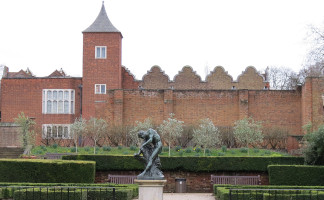
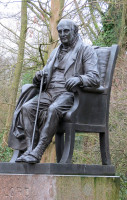
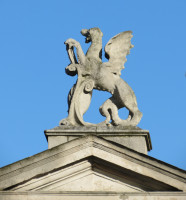
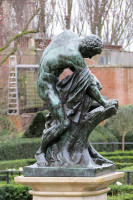
Holland Park in West London is conveniently reached from the north end by a short walk from Notting Hill Gate (which takes the visitor past the statue of St Volodymyr [Vladimir] of Kiev, see this page), or from the south side a stroll from High Street Kensington. It is not a very large park, and contains a fair selection of statues, including one important portrait statue, of the third Lord Holland, several studies of the male nude, and a few other things of interest. The park is centred on Holland House, or what is left of it, of which more anon.
We start from the northern end, because this brings us naturally to the portrait statue of Lord Holland, raised on a red granite plinth in a fountain a little to the north of Holland House.
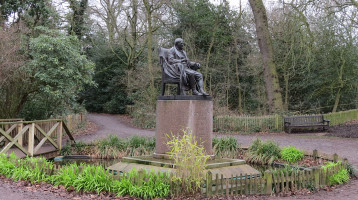
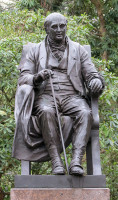 Lord Holland statue, by G. F. Watts and J. E. Boehm.
Lord Holland statue, by G. F. Watts and J. E. Boehm.
The statue was the work of G. F. Watts, the Victorian painter-sculptor, with J. E. Boehm providing technical help in casting. It is one of those rather understated portrait works which at first sight seems of no great moment, but repays further contemplation. Lord Holland is seated on a throne-like chair, slightly leaning forward rather than relaxing back, wearing modern attire and a cloak on which he is seated and which hangs asymmetrically to one side. One hand holds a cane, and he is shown in late middle age. There is no attempt at flattery, but a sense of dignity, an assured figure who needs no embellishment but is as he is. The expression, like the statue as a whole, is understated, and seems to me somewhat wry, indicating a self-deprecating intelligence. The modern clothes do not allow for a Classical treatment of the drapery, but the looseness of the trousers and largeness of the coat allow for some considerable volume of folds, adding texture and variety to the composition.
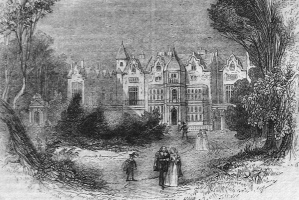
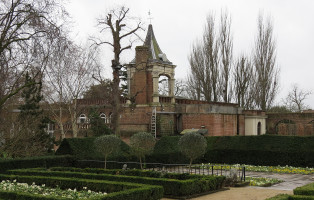 Holland House, 1840s and now (and see top of page).
Holland House, 1840s and now (and see top of page).
Next we come to Holland House itself. It had been built by a certain Sir Walter Cope in 1606, and passed thence to Henry Rich, Earl of Holland, who beautified the mansion, and gave it its modern name. It featured in various episodes connected with the Civil War, was confiscated and then returned to Holland s widow, became the residency of Addison by virtue of his marriage to the Dowager Countess of Warwick and Holland, and in the 1760s came into the possession of Henry Fox, afterwards Lord Holland. The splendid and idiosyncratic mansion fell victim to WW2 bombing, and what we see today is the surviving East Wing now a youth hostel and south Terrace, reduced to a single storey and remodelled after purchase by the local council in the 1950s. The strange restored tower can be recognised as one of several from the original building, and the remaining arcades and walls have been sensitively and elegantly maintained, with pleasant gardens and, of course, our bits of sculpture. In the 19th Century, the House contained the original mould for Sir Richard Westmacott's statue of C.J. Fox in Bloomsbury Square, but I think this must have perished, perhaps in the bombing.
Holland House gates, Inigo Jones and carving by Nicholas Stone, detail of terra cotta, tilework.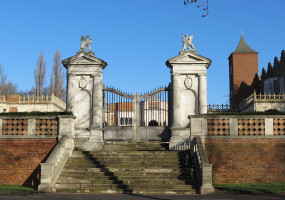
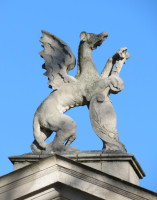
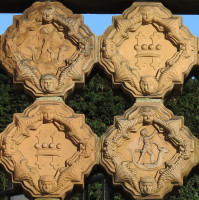
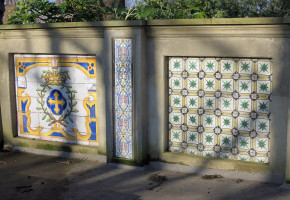
The excellent gate piers, in white Portland Stone, an addition to the original house and moved from their former position, are to the design of the architect Inigo Jones, and with carving by Nicholas Stone. The two summit sculptures, heraldic griffins or dragons, are much worn, but retain a greyhound-like elegance and considerable spirit (for lots more dragon sculptures, see this page). Along the wall are openwork panels of repeating terra-cotta tiles, 1860s I would think or a bit later, showing alternating coronets and small cherubs riding on dragon-headed boats. Childish heads, seashells and twisted rope designs form the borders of each tile. Up on the open terrace are panels of coloured tiles of various repeating designs, which along with gate piers and terra cotta add to the sense of ruined grandeur.
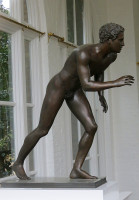
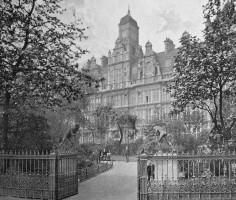 One of the Wrestler statues, and view of them in Victoria Embankment Gardens.
One of the Wrestler statues, and view of them in Victoria Embankment Gardens.
In what is now the caf are an Eric Gill nude, called The Maid, taken indoors to avoid deterioration from the weather, and close to it, a panel with a stylised male nude, a Sun God, by Epstein. Also two male nude bronzes, the Wrestlers of Herculaneum, small casts after the originals from that ancient city. The sculptor of these 19th Century works is not known; they used to be sited at the entrance to one of the gardens on the Victoria Embankment, within living memory of a correspondent with this site - see above right, but you will need to click to enlarge to see them properly. They show an ideal male type, youthful and lightly athletic rather than heavily muscular.
There is a contrasting Classical type, in small size, in one of the surrounding gardens, much more muscular, older, more Renaissance than Greek in style, but depicting the ancient figure of Milos of Croton, who tested his strength on a split tree-trunk, only to be trapped, to fall prey to wild beasts. The work is 19th Century, likely Italian in origin, but unsigned. A small list of Italian sculptural interest in London on this website is noted on this page.
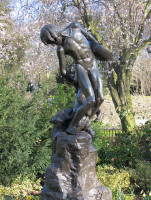 Boy with bear-cubs, by J. M. Swan.
Boy with bear-cubs, by J. M. Swan.
Next, on a shady path by the House, is the group Boy with Bear-Cubs, which like the Milos is a very three dimensional piece intended to be viewed from all round. The young boy twists around on his treestump pedestal to view one bear climbing up, and in the process tips his bowl of tit-bits to one side, where the second bear rears up for an easy snack. The sculptor was J.M. Swan, one of a rather small number of late Victorian British sculptors specialising in animals, and this work is characteristic both in terms of the treatment of the animal (though he is best known for big cats), and in the attenuated vertical composition of a raised-up nude figure with animals below. This work was shown at the Royal Academy in 1902, and is a long-term loan from the Tate.
Finally among the figural statues is a clothed male figure, a stone statue of a bearded man in robes and hat, believed to be 16th Century, which is plausible. His outer cloak is clasped at the front by a single button, and one extremely decayed hand emerges in front ot hold a small pot. Other drapes mean that we see little of the figure itself, but there is something of a slight sway to the pose. The facial features are ridiculously placed and contorted, but I would think this represents a misconceived recarving of a highly weathered head rather than indicative of the intent of the original sculptor. The hair, cut bumpkin style, would also look to be recarved.
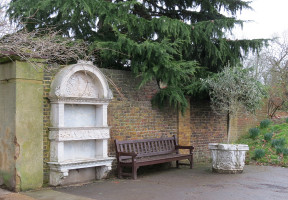
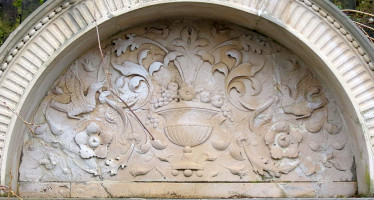
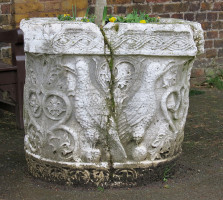 Garden ornaments with carving in relief.
Garden ornaments with carving in relief.
Still in the same garden and against the same wall, we should note the nicely carved Dutch structure, some sort of trough with upper stages, on the front of which are low relief carvings: pilasters with pot-plants and birds, sphinxes with leaves and cherubic heads, and a light composition of fruit bowl, leaves, flowers and birds in the curved pediment. By it is a cracked bowl, with somewhat celtic repeating patters and a pair of crows, heavily carved with a certain strength.
Elsewhere in the gardens we may note there are several modern works, mostly abstract, and not for this website; a couple are shown here.
St Volodymyr statue to north of Park // London sculpture
Visits to this page from 13 Mar 2014: 18,271